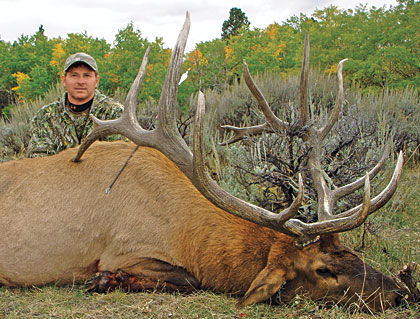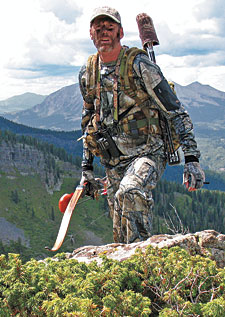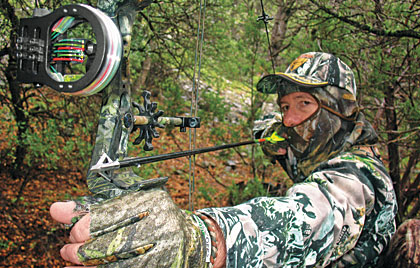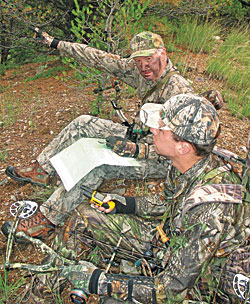November 01, 2010
Boost Your Success Rate with this Time-Tested Wisdom...
By Patrick Meitin
 Doing your homework well ahead of your hunt, getting into good shape and learning to remain flexible help you beat those odds. |
Elk and whitetail deer occupy opposite extremes of the big-game spectrum, yet more bowhunters than ever are leaving whitetail country behind each fall to pursue the West's majestic Rocky Mountain elk. The popularity of elk has grown at a meteoric pace, not so difficult to understand given their awe-inspiring habitat, sheer size and gregarious nature. Elk numbers are stable or expanding across much of their range and modern bowhunting equipment is more efficient than ever, yet eight in 10 visiting elk hunters are destined to fail because they're unprepared for the daunting conditions or simply unfamiliar with the unique rules of engagement. Twenty-three years guiding bowhunters to elk unequivocally taught me this.
In elk hunting, three absolutes help set you apart from the crowd. Use them and avoid becoming part of the ugly failure statistics.
Advertisement
Get In Shape!
The bull's lovelorn bugles lured us like a siren's song. His destination had become obvious; a deep saddle offering passage through a formidable ridgeline, like the gates of an ancient city-state opening into lush meadows liberally pocked with bomb-crater wallows. Success was suddenly feasible -- if we could only skirt the wind and arrive in time.
Advertisement
We climbed as daylight rolled in like an incoming tide. Our legs pumped like pistons, flooding with lactic acid. My charge wheezed like a sprinter in a distance race, but he was doing a respectable job keeping pace. It was coming together. Then, with the finish line within grasp, a strange thing happened. My hunter suddenly sat down and surrendered.
Ten minutes later, the 380-ish bull lumbered through the saddle where we should have been huddled in ambush.
Elk hunting is decidedly physical. If altitude doesn't sap you, steep terrain and long miles certainly will. Visiting bowhunters are at an unquestionable disadvantage, because you simply can't simulate high altitude if you live at sea level. In elk country, there's less oxygen, meaning you work that much harder simply breathing. Making matters worse, most people nowadays earn their livings behind desks. This allows you to grow soft and puts you at an even bigger disadvantage.
Simply put, the better physical shape you're in, the better chance you have of tagging your elk. Physical fitness allows you to better deal with sudden altitude gain and keep pace in twisted terrain. Physical training needn't dominate your entire life -- strenuous cardiovascular exercise for a couple hours, four days a week, is normally sufficient. Jogging or treadmill work is an obvious solution, starting months ahead of season, slowly easing into more miles. Vary workouts, investing in long jogs one day, shorter, high-intensity sprints another, running stairwells or steep hills another, strengthening various muscle groups important to mountain travel. This increases stamina and the ability to efficiently process oxygen. Just as importantly, strenuous workouts increase your mental toughness by stretching your threshold for pain and helping you better understand your physical limits. Most people are tougher than they believe, but few ever push themselves hard enough to discover it.
 Most visiting elk hunters (above) travel from sea level or close to it and are suddenly subjected to altitudes from 7,000-10,000 feet above sea level, where air seems to have no substance. Being in top physical condition helps you acclimate faster. Traveling out of state to new and strange game country stacks the odds of success firmly against you. |
Shoot Farther!
I didn't understand we were in trouble until my client and I had invested an entire morning dogging over gut-busting, roller-coaster terrain, running or stalking according to the sporadically bugling bull's movements, and arrived within a comfortable 40 yards. Moments before, we'd watched him fall into an abrupt gully, allowing us to make a hurried but quiet 80-yard scramble and ease over the gully lip to discover the gorgeous 6x6 broadside, nibbling tender oak leaves.
"He's all yours," I whispered into my dude's ear after hitting the bull with a laser pop. "Forty yards -- slam-dunk. Take your time, but hurry."
I trained binoculars on the bull's ribs. And I waited. Nothing happened, and I turned to see my guy antsy with indecision. Trying to remain calm, I whispered, "Shoot, now." He tugged on his bowstring tentatively and aimed overlong. The bull started to move as his string slipped away and the arrow sailed wildly wide.
I offered encouragement. "Where the heck did you learn to shoot?"
"I didn't know where to hold," he said. "I've never shot 40 yards before."
A quick glance at his sight, which held only two pins, raised another question. "What are those pins sighted for," I asked. I'm all for simplicity, but that's taking things a bit too far.
"Fifteen and 25," he said. Truly an odd combination; especially in an elk-hunting context. Until that moment, I thought I had it made, paired with someone who matched me step for step physically, who from all indications was an accomplished bowhunter, calm and steely nerved.
It's beyond frustrating -- for all involved -- to work so hard to arrive in range of a trophy bull only to miss a "gimme" shot. Stand hunting whitetails hardly prepares one for shots at elk. Sure, you'll occasionally plunk trophy bulls at whitetail range -- say anything less than 30 yards -- but you certainly can't bank on it. In elkdom, to make the most of hard-earned shot opportunities, a confident maximum range of 45, 50 or even 60 yards increases your odds of success exponentially.
 One thing is certain when bowhunting elk; average shot distances will well exceed those normally presented by whitetails. Prepare for such contingencies by increasing your effective maximum effective range. |
This isn't nearly so difficult as it once was. Modern compound bows, carbon arrows and broadheads, not to mention accuracy-enhancing drop-away rests, active stabilizers
and precise, fiber optic sights, make 50-yard shots the new 30, to borrow from the witticism regarding modern health and aging. This isn't automatic, of course, and requires some small effort and shooting savvy. But it no longer represents the ethical dilemmas it once posed. This involves finer equipment tuning, polishing shooting form (especially follow-through) and smart practice. Pore over magazine articles and books on these subjects. Seek the services of a qualified shooting coach. If you can extend your maximum effective range a mere 10 yards, your odds of elk success improve dramatically.
Along with being able to shoot farther, you need to be able to think on your feet as a shot develops. In elk hunting, you shoot when game dictates, not when you're ready, as is often the case while installed in a whitetail stand. This means taking advantage of fleeting opportunities, less-than-ideal shot angles, even walking shots; though it's still imperative to apply the discipline necessary to hold off when a shot simply doesn't feel right. Regular stump shooting and small-game hunting will better prepare you for this than target shooting.
 Calling a snot-slinging, wild-eyed bull into bow range is certainly the stuff of elk-hunting legend, but in today's hard-hunted woods it's certainly not a ploy you can bank on. A multi-pronged approach to success assures you remain one step ahead of your quarry |
Stay Flexible!
We were in the thick of it, an estrus cow or properly aligned planets sparking a frenzy of whistling, grunting proclamations and frantic chirps created by no fewer than 50 elk. We were closing quickly, and something was going to happen. Suddenly, there was an urgent tugging at my shirtsleeve, breaking my concentration. I shot my charge, an editor at a prominent bowhunting magazine and elk expert, an impatient look. I knew what he had in mind.
"Let's set up and call," he insisted. Every time we got anywhere near bugling bulls, this is how it was -- the shirt tugging, the nagging insistence that I produce a call. The two raghorn bulls he'd taken on guided hunts on exclusive private land apparently came this way. I'd had enough.
"All right, if you insist," I said finally.
I produced a call and loosed a couple beautiful cow mews, followed shortly by a squealing spike bugle to add to the general mayhem. The elk fell conspicuously silent, like a raucous bar fallen abruptly silent after someone belligerently kicked the jukebox off track. The editor tensed with anticipation, convinced all those elk fell silent in their hurry to investigate the new arrivals. I tried more subtle calls, and with time, it became blatantly obvious I was playing to an empty concert hall. Those once gregarious elk had slipped away like smoke, not to be seen again.
I'd confirmed what I already knew all too well. Two weeks into the season, those elk had heard it all from eager bowhunters "practicing" on new calls while scouting ahead of season, to arrows narrowly whistling past after responding to the latest call sensation, to lazy archers calling from recently killed ATVs or pickup windows. Had we left the calls in our packs we had a chance. We'd literally blown our chances of plucking one of those randy herd bulls from the fray. Worse yet, I knew better.
 Simply getting to productive elk country can prove half the battle. The only way to get there in most cases is by putting one foot in front of the other. Arriving in the best shape of your life not only makes your hunt more enjoyable but increases your chances of success. |
This isn't to say calling doesn't have its time and place, as obviously it does, evidenced by the latest dramatic elk-hunting video. This wasn't the time or the place, and illustrates a common shortcoming of the average elk-hunting tyro. They arrive with a single agenda, a single plan of attack, on which they hang all their hopes and dreams. They dream of calling in a trophy bull, just like they saw on TV, but the elk they play to prove call weary and impervious to their best efforts. They're convinced a sign-pounded waterhole is the answer to their prayers, but it rains three days straight and turns every bar ditch and pothole into a potential watering site. They plan to dog bugling bulls, but unseasonably warm weather turns bulls tight-lipped, or footing simply proves corn-flake noisy. So, they are at a loss as to how to proceed. Their hunt is essentially finished unless they are able to change gears by reaching deeper into their elk-hunting bag of tricks.
Any savvy elk hunter carries an array of elk calls, but rarely becomes wholly dependent on them for success. Productive water can result in often untouchable trophy bulls when it's dry and hot, but rain can quickly slap a damper on festivities, though wallows might still do the trick. Dogging bugling bulls comes into its own during wet periods, cooling things off to encourage rutting, making the ground stalking quiet. Heat can postpone rutting activities, and bugling especially, but elk can still be hunted using the patient spot-and-stalk ploys applied to deer. On hard-hunted ground, bulls might clam up and take to the thickest cover possible, asking for honed still-hunting skills.
The point is regular success on public-land bulls requires a flexibility required by few other big-game animals. Weather, hunting pressure, ranching activity, moon phase, global warming and sunspots can conspire to foil the best laid plans. Keep an open mind; remain open to new, or less popular, approaches. It might not be what you had envisioned for your long-awaited elk hunt, but regular success can depend on it.
